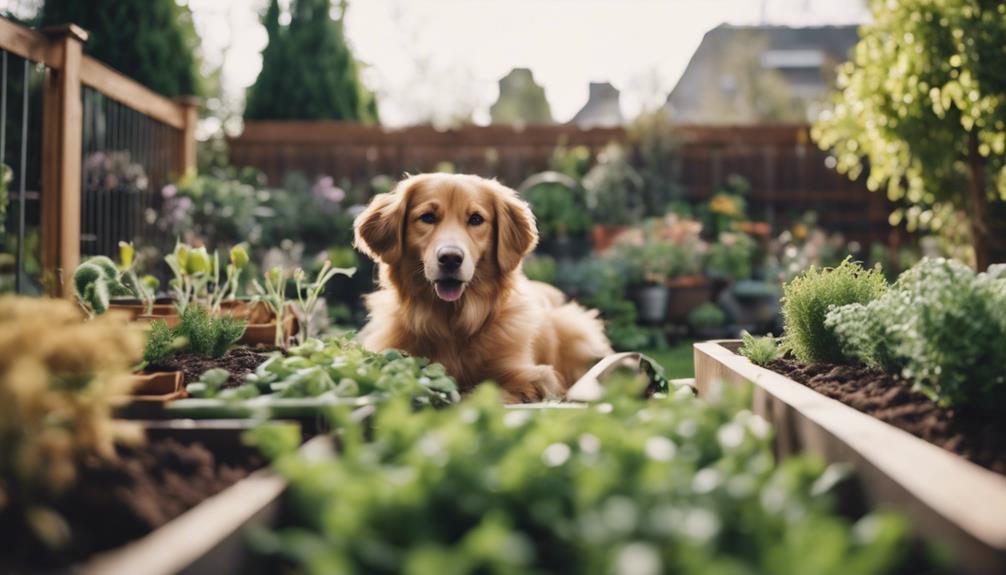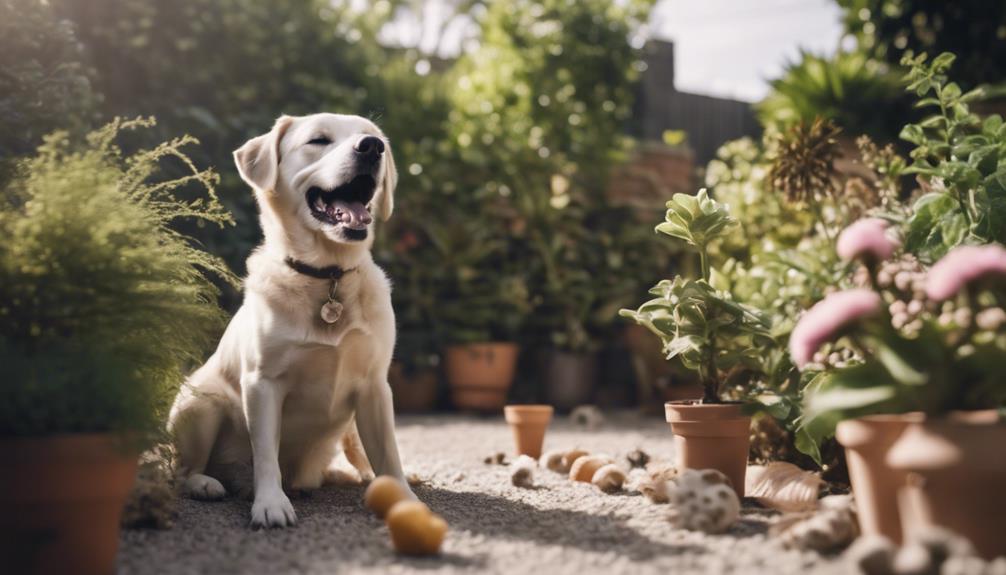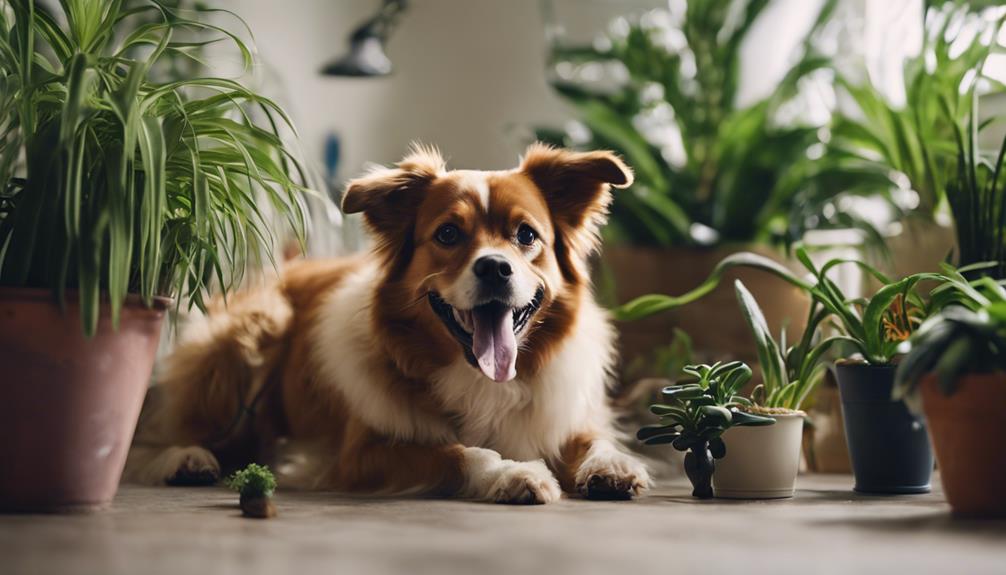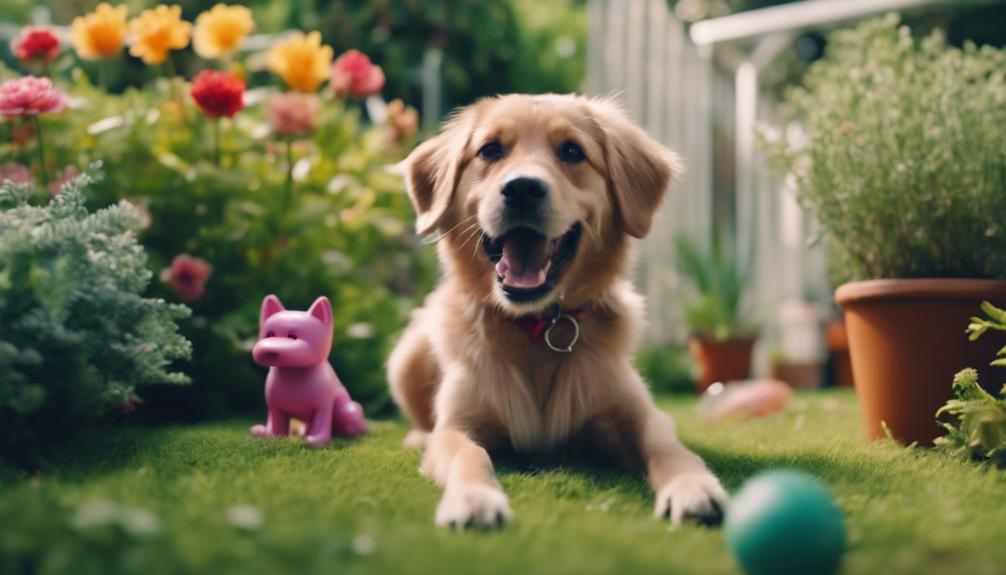To prevent your dog from rummaging through and protect your plants, first understand the root cause of this behavior. Dogs may forage out of boredom or curiosity. Adjusting the height of plants, using deterrents, and implementing positive reinforcement training can be helpful strategies. Creating a dog-friendly area with non-toxic plants and observing behavior can also prevent this habit. Redirecting your dog’s focus with toys and treats can help deter them from the plants. By combining these techniques, you can effectively discourage foraging habits and promote a peaceful environment. Explore more comprehensive approaches to address this issue.
Key Takeaways
- Utilize positive reinforcement for desired behaviors.
- Implement strategic plant placement out of reach.
- Offer mental stimulation with interactive toys.
- Create designated plant-free zones for safety.
- Monitor and redirect attention towards approved activities.
Understanding Your Dog's Foraging Behavior
To understand your dog's foraging behavior, it's important to recognize the various motivations that drive this instinctual activity. Dogs may forage for reasons ranging from seeking attention to alleviating boredom or simply exploring their environment. This behavior can be reinforced through finding hidden treats, accessing plants, or even receiving attention from you, their owner. Understanding these motivations is vital in implementing effective behavior modification strategies to redirect your dog's foraging tendencies.
In order to deter your dog from eating plants or engaging in unwanted foraging behavior, it's essential to provide mental stimulation and enrichment activities. Interactive toys and engaging tasks can help keep your dog mentally engaged and less likely to resort to foraging. Behavior modification techniques can also be employed to discourage undesirable foraging habits and encourage more appropriate behaviors.
Strategic Plant Placement Tips

When strategically placing plants to prevent your dog from foraging, consider their height to make sure they're out of reach.
Using natural deterrents like citrus peels or vinegar can help discourage your pet from approaching certain plants.
Installing barriers such as fencing or plant stands can also be effective in keeping your dog away from potentially harmful vegetation.
Plant Height Consideration
Consider adjusting the placement of your plants based on their height to prevent easy access for your foraging dog. When selecting plants for your home, take into account their height to keep them out of reach of curious pets.
Opt for taller plants or utilize hanging baskets to discourage dogs from nibbling on your greenery. Elevated plant stands or shelves can also serve as a barrier, preventing pets from reaching and potentially damaging your plants.
By placing plants higher up, you create a visual barrier that reduces the temptation for dogs to explore them. Strategic plant placement based on height not only protects your plants but also safeguards the safety of your furry friends.
Maintaining a balance between your love for gardening and your pet's well-being is essential, and considering plant height is a simple yet effective way to achieve this harmony in your home.
Natural Deterrents Usage
Adjust the placement of your plants strategically by incorporating natural deterrents to dissuade your dog from foraging. Here are three tips to help keep your furry friend away from your precious plants:
- Plant Selection: Choose vegetation with strong scents or textures that are unappealing to dogs. Citronella, prickly succulents, lavender, or rosemary can act as natural barriers, deterring your dog from exploring and munching on your garden.
- Natural Repellents: Utilize household items like cayenne pepper, vinegar, or citrus peels around your plants. These scents are unpleasant to dogs and can help keep them at bay, preventing them from getting too close and foraging.
- Odor Masking: Use plants with overpowering odors like mint or marigolds to mask the scents that attract dogs. By camouflaging the enticing smells, you can discourage your dog from seeking out your plants for a snack.
Incorporating these natural deterrents strategically can go a long way in keeping your garden safe from your curious canine companion.
Barrier Installation Tips
To ensure the protection of your plants from your dog's foraging tendencies, implement strategic barrier installation tips such as using sturdy fencing or pet-proof plant stands.
Installing tall pet gates or decorative fencing can act as a vital barrier, preventing your dog from accessing and eating your plants. Consider elevating your plants out of reach by using indoor shelving or pet-proof plant stands. These barriers should be durable enough to withstand your dog's attempts to reach the plants.
Strategic plant placement can also play an essential role in deterring dogs from foraging. By positioning plants in areas that are difficult for your dog to access, you can effectively keep them safe.
Proper barrier installation and plant placement are key in protecting your plants from your dog's natural instincts. Remember to choose barriers and plant placements that not only serve the purpose of keeping your plants safe but also blend well with your overall aesthetic.
Positive Reinforcement Training Techniques

Positive reinforcement training techniques involve rewarding your dog when they exhibit desired behaviors, such as following commands or refraining from foraging.
Utilizing treats, toys, praise, and attention as rewards can help reinforce these positive behaviors and strengthen the bond between you and your pet.
Consistency in applying these rewards is essential to effectively encourage the behavior you want to see in your furry companion.
Reward-Based Training Methods
Engage your dog in reward-based training methods to deter foraging behaviors effectively. Positive reinforcement techniques are powerful tools in shaping your dog's behavior towards what you desire.
Here's how to implement them successfully:
- Use Treats, Praise, and Toys: Reward your dog with treats, verbal praise, or playtime whenever they exhibit the desired behavior of not foraging. This positive association will encourage them to repeat the behavior.
- Consistency is Key: Be consistent in rewarding your dog for not foraging. Dogs learn through repetition and association, so ensuring they receive rewards every time they resist the urge to forage will reinforce the behavior.
- Build a Strong Bond: Positive reinforcement not only helps in stopping foraging but also strengthens the bond between you and your dog. By rewarding good behavior, you create a positive environment that fosters trust and cooperation, leading to long-term changes in their behavior.
Encouraging Desired Behaviors
Implementing reward-based training techniques can effectively encourage your dog to exhibit desired behaviors like ignoring plants and avoiding foraging. Positive reinforcement training involves using treats, praise, or toys as rewards to reinforce the behavior of steering clear of plants. By consistently praising and rewarding your dog for not engaging with plants, you can train them to avoid foraging successfully. This method helps create a strong connection between good behavior and rewards, making it more likely for your dog to repeat the desired actions.
Encouraging desired behaviors through positive reinforcement can be a powerful tool in stopping your dog from foraging and protecting your plants. Remember to be consistent in your approach, offering rewards each time your dog displays the desired behavior. With patience and persistence, you can effectively train your dog to ignore plants and focus on more appropriate activities.
Consistency in Reinforcement
Maintaining consistency in reinforcing desired behaviors is key to effectively training your dog to avoid foraging. When it comes to positive reinforcement training, consistency is vital for your furry friend to understand what actions are desirable. Here are three essential points to keep in mind:
- Clear Expectations:
Consistently rewarding your dog for exhibiting the desired behaviors sets clear expectations. This helps your pet understand what actions lead to positive outcomes, making it more likely for them to repeat those behaviors.
- Timely Rewards:
Providing rewards promptly after your dog displays the desired behavior strengthens the association between the action and the reward. This immediate reinforcement helps your dog connect the dots and reinforces the behavior you want to encourage.
- Variety in Rewards:
Using a variety of rewards such as treats, praise, toys, or playtime keeps the training sessions engaging for your dog. It also ensures that the rewards remain motivating and exciting, encouraging your pet to continue displaying the desired behaviors consistently.
Designing a Dog-Friendly Space

When designing a dog-friendly space, it's essential to arrange plants on raised surfaces or stands to prevent easy access for your pet. Keeping your furry friend away from potentially harmful plants is crucial for their well-being. Monitoring and redirecting your pet's attention when they get close to plants can help reinforce boundaries. Using toys or treats as distractions can be effective in redirecting your pet's focus. Additionally, creating a designated plant-free area for your pet to roam freely without the temptation of plants is a smart strategy. Regularly assessing your pet's behavior around plants allows you to make adjustments as needed for a harmonious pet-friendly environment. Ensuring the safety of your pet while maintaining a green space requires thoughtful planning and proactive measures.
| Keep Plants Elevated | Opt for Pet-Friendly Plants | Monitor Pet Behavior | Create Plant-Free Zones |
|---|---|---|---|
| Arrange on raised surfaces | Choose non-toxic options | Watch for proximity to plants | Designated safe areas |
Selecting Pet-Friendly Plants

Select pet-friendly plants such as Spider Plants, African Violets, and Bamboo Palm to guarantee a safe environment for your dog.
When choosing plants for your home, consider these factors:
- Toxicity Levels: Opt for non-toxic plants like Boston Ferns, Parlor Palms, and Calathea to secure a pet-friendly indoor space for your furry friend.
- Safety and Aesthetics: Look for plants such as Haworthia, Peperomia, and Polka Dot Plant that not only enhance the beauty of your home but are also safe for your pets to be around.
- Well-being Prioritization: Research pet-safe options like Friendship Plants, Blue Echeveria, and Ponytail Palm to elevate your living space without compromising your dog's health.
Monitoring and Adjusting Behaviors

Keep a close eye on your dog's interactions with plants to proactively address any foraging behavior. Monitoring your dog's behavior is essential in catching foraging attempts early on. By observing patterns and triggers that lead to this behavior, you can adjust your training and management techniques accordingly.
If you notice your dog showing interest in certain plants or areas, implement consistent redirection strategies to deter them from eating the plants. Stay proactive by supervising and guiding your dog whenever they're near plants, reinforcing positive behaviors and redirecting any negative ones.
Redirecting Attention With Toys and Treats

Use interactive toys and engaging treats to redirect your dog's attention away from foraging on plants. Here's how to effectively utilize these tools:
- Choose the Right Toys: Opt for interactive toys such as puzzle feeders or chew toys that can mentally stimulate your dog and keep them entertained. These toys provide a constructive outlet for your dog's energy and curiosity, reducing the likelihood of them turning to your plants for entertainment.
- Reward Positive Behavior: When your dog engages with the toys instead of the plants, reward them with treats. This positive reinforcement helps your dog associate playing with toys with receiving tasty rewards, encouraging them to continue this behavior.
- Offer Variety: Provide a variety of toys and treats to cater to your dog's preferences. Different textures, flavors, and types of toys can keep your dog engaged and excited, making the playtime more enjoyable and effective in redirecting their attention from foraging on plants.
Teaching Peaceful Cohabitation

To teach your dog peaceful cohabitation with plants, implement training methods emphasizing positive reinforcement and redirection. Spend time helping your furry friend understand which areas are off-limits by redirecting their attention to appropriate activities. Additionally, creating a designated play area for your dog can help prevent them from accidentally damaging your delicate plants. Check out the table below for some practical tips on how to achieve peaceful cohabitation between your dog and your plants:
| Tips for Peaceful Cohabitation | |
|---|---|
| Positive Reinforcement | Reward good behavior with treats or praise. |
| Redirection | Guide your dog's focus towards approved toys and activities. |
| Designated Play Area | Establish a safe space for your dog to explore and play. |
| Monitoring and Adjusting | Regularly check plant placement and access to prevent unwanted foraging. |
Implementing a Multi-Modal Approach

Implementing a multi-modal approach is essential in effectively addressing your dog's foraging behavior and safeguarding your plants. To tackle this issue successfully, consider the following strategies:
- Training: Engage in positive reinforcement training to redirect your dog's attention away from your plants. Teach commands like 'leave it' and 'drop it' to discourage foraging behavior.
- Environmental Management: Make changes to your environment by rearranging plants to make them less accessible or creating designated digging areas to satisfy your dog's natural instincts without harming your garden.
- Enrichment: Provide your dog with stimulating toys, puzzles, or activities to keep them mentally and physically engaged. By offering alternatives that are equally rewarding, you can help deter them from foraging in your garden.
Frequently Asked Questions
How Do I Stop My Dog From Foraging?
To stop your dog from foraging, use positive reinforcement training, offer engaging toys, and consider using pet-safe barriers. Supervise your dog closely in the yard and consult a professional trainer if needed for specialized help.
How Do I Get My Dog to Stop Eating My Plants?
Want to stop your dog from eating your plants? Redirect their focus with positive reinforcement, use deterrents like bitter sprays, and provide engaging alternatives. Supervise them consistently and choose pet-friendly plants to keep both your dog and garden safe.
How Do I Keep My Dog From Killing My Plants?
To keep your dog from killing your plants, use barriers, engaging toys, and elevated water bowls. Train with cues like 'leave it' and opt for pet-friendly plants. Monitor behavior and offer positive reinforcement.
How to Keep Dogs From Pulling up Plants?
To keep dogs from pulling up plants, create a barrier with tall gates or fencing, offer engaging alternatives like chew toys, and supervise outdoor time closely. Reward good behavior, interrupt bad habits, and provide mental challenges for distraction.
Conclusion
To sum up, with a little patience and consistency, you can successfully curb your dog's foraging habits and protect your beloved plants. Remember to strategically place plants, use positive reinforcement training, create a dog-friendly space, choose pet-friendly plants, and monitor and adjust behaviors as needed.
By implementing a multi-modal approach, you can guarantee a harmonious cohabitation between your furry friend and your garden. With these tips, you'll be stopping your dog from foraging in no time, saving your plants from potential destruction.










